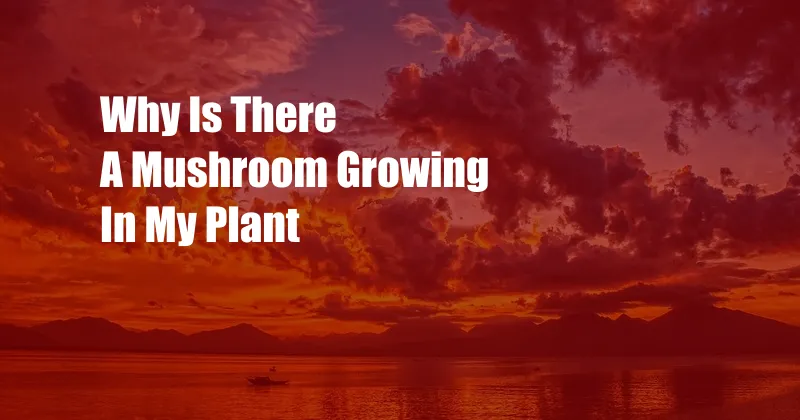
Why Is There a Mushroom Growing in My Plant?
One morning, as I was tending to my indoor plants, I noticed something peculiar – a large, white mushroom had sprouted from the soil of my peace lily. I was immediately intrigued by this unexpected sight and set out to uncover the reasons behind its appearance.
Upon further inspection, I realized that the mushroom was likely a species of Agaricus bisporus, commonly known as the white button mushroom. This species is known to thrive in moist, organic environments, such as the soil of potted plants. As the soil in my plant had been consistently damp due to my recent overwatering, it had created the ideal conditions for mushroom growth.
Mushroom Growth in Plants: A Closer Look
Mushrooms are not plants but rather fungi. They belong to the kingdom Fungi, which includes a diverse group of organisms that lack chlorophyll and derive their nutrients from organic matter. Mushrooms are composed of a network of fine, thread-like structures called hyphae, which form a mycelium. This mycelium is responsible for absorbing nutrients from the surrounding soil or other organic matter.
When conditions are favorable, the mycelium can produce fruiting bodies, which are the structures we commonly refer to as mushrooms. These fruiting bodies serve as reproductive structures and release spores that can disperse and germinate to form new mycelia, thus completing the fungal life cycle.
Managing Mushroom Growth in Plants
While mushrooms can be an interesting and harmless addition to your indoor plants, there are a few steps you can take to manage their growth and prevent them from becoming a nuisance:
1. Adjust Watering Habits: Overwatering can create the ideal conditions for mushroom growth. By reducing the frequency and amount of watering, you can help to prevent excess moisture buildup in the soil.
2. Improve Drainage: Make sure that your plant pots have adequate drainage holes to allow excess water to escape. Poor drainage can lead to waterlogging, which promotes mushroom growth.
3. Remove Mushrooms: If mushrooms do appear, simply remove them by gently pulling them out of the soil. Avoid cutting or damaging the mycelium, as this can stimulate further mushroom growth.
4. Repot the Plant: If the mushroom infestation is persistent, you may need to repot the plant into fresh, uncontaminated soil. Be sure to thoroughly clean the pot and roots before replanting.
Expert Advice for Managing Mushroom Growth
In addition to the tips mentioned above, here are some expert insights on managing mushroom growth in plants:
1. Use a Fungicide: If other methods fail to control mushroom growth, you can consider using a fungicide specifically designed for indoor plants. Follow the instructions on the product label carefully to avoid damaging your plants.
2. Keep the Plant Clean: Remove any dead or decaying leaves or debris from around the plant, as these can attract pests and promote fungal growth.
Frequently Asked Questions (FAQ)
Q: Are mushrooms harmful to plants?
A: While mushrooms themselves are not typically harmful to plants, they can indicate that the plant is overwatered or that the soil is too moist. This can eventually lead to root rot and other problems.
Q: Why are there mushrooms growing in my new plant?
A: Mushrooms can grow in new plants if the soil or potting mix has been contaminated with mushroom spores. These spores can be dormant for long periods of time and germinate when conditions are favorable.
Q: Can I eat the mushrooms that grow in my plants?
A: It is generally not advisable to consume mushrooms that grow in your plants, as they may be contaminated with pesticides or other harmful substances.
Conclusion
Mushrooms growing in your plants can be a curious and unexpected sight. By understanding the conditions that favor mushroom growth and following the tips provided in this article, you can effectively manage their presence and maintain the health of your indoor plants.
Are you interested in learning more about mushroom growth in plants? Let us know in the comments below, and we’ll be happy to provide additional insights.